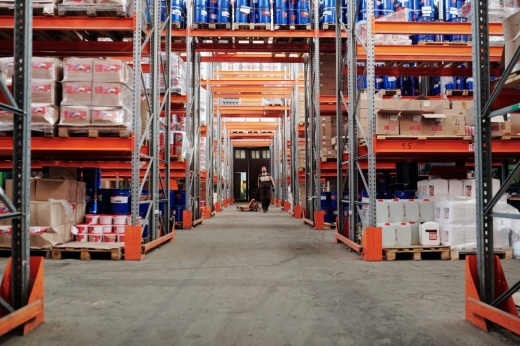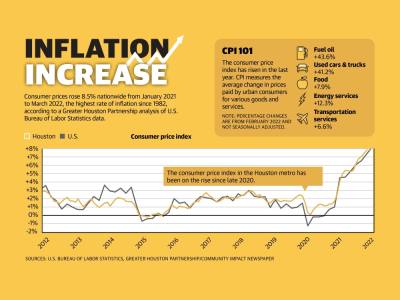February survey data from the Federal Reserve Bank of Dallas revealed 64.7% of Texas business owners experienced supply chain disruptions or delays in February with 26.9% reporting that they do not expect the supply chain to go back to normal until more than a year has passed.
According to Keri Schmidt, president and CEO of the Fort Bend Chamber of Commerce, supply chain disruptions in the Sugar Land and Missouri City area have largely been industry-specific.
“I'm hearing about challenges from a number of companies, especially ones that are in the manufacturing sector,” Schmidt said. “In the service sector, that is not an issue, and a lot of our businesses are in the service sector.”
Houston’s economy, meanwhile, has recovered and rebounded from shutdowns, oftentimes resulting in more demand than there is supply, said Patrick Jankowski, senior vice president of research for the Greater Houston Partnership.
“We shut everything down in March and April of 2020, and we realized we didn’t need to shut it down,” Jankowski said. “So things started opening back up, and that’s when we saw the first surges in growth. The last quarter of 2021 was just incredibly strong. It was the strongest quarter on record for job growth.”
With businesses fully operational, they need as many hands as they can get, meaning less flexibility in scheduling than there was a year ago, Jankowski said.
Costs for goods and supplies are higher for these mom and pop shops as well, making it more difficult to raise wages and leaving a gap in production as more people go out to shops or eat at short-staffed restaurants.
A March inflation update from the Bureau of Labor Statistics reported an 8.5% rise in consumer prices nationwide since the start of 2021. In Febru ary, the Houston area was at 7.8%. The GHP also reported a 5.1% increase in job creation in 2021 with 151,800 positions created.
This influx of job opportunities has left many businesses struggling to find enough employees, Schmidt said. When faced with these challenges, Sugar Land and Missouri City businesses have adapted and persevered, she said.
Ongoing challenges
Many of the issues businesses are facing are related to the supply chain—the flow of goods from the producer to the customer—which was essentially halted when the pandemic first hit and nations ceased trading and shipping, Jankowski said.
Although many ports have reopened, variant outbreaks still pose a threat to this system, leaving business owners wondering how they will cope with the increased costs. One such local business is Mexican-Pakistani restaurant Mint n Chili, which has struggled to purchase the organic meats and produce the restaurant needs along with other products such as to-go containers.
“There’s all of this shortage now compared to before the start of the pandemic,” owner Shahid Parada said. “Before, back when I was in California, or anywhere, really, it was very easy to get everything, but now it’s very difficult.”
Parada’s restaurant, which offers burritos, tacos, and bowls that combine the flavor of Mexico with Pakistani spices, uses organic ingredients as well as Halal meat that has grown in cost, Parada said.
“Meat like lamb, which I use a lot of in my restaurant, I used to be able to buy for $3.49 per pound, but now for the same lamb, it costs $6.54 per pound,” he said.
Jankowski said other businesses have turned to Walmart or Target to stock their coolers with sodas and their shelves with cups as their usual providers limit distribution.
Alongside supply chain disruptions are staffing shortages. Local business leaders agreed people have come to expect higher pay for what are coined “behind-the-counter” jobs. Jankowski said he believes this is due in part to people becoming accustomed to working from home or having more flexibility during the peak of the pandemic.
Jankowski reported there are around 92,000 fewer workers in the Houston region now than there were a year ago.
That shortage has had a trickle-down effect on other entities, such as Fort Bend ISD, a member of the Region 4 Education Service Center alongside dozens of other Greater Houston-area districts that have experienced food service supply challenges partly due to suppliers not having enough employees.
“I’ve been told, ‘We’ve got an employee shortage,’” said Matt Antignolo, Fort Bend ISD’s executive director of child nutrition. “‘We normally would run five assembly lines, but now we are running with two, or in some cases, one assembly line.’”
Suppliers have been challenged to meet the demand across the country, and for FBISD, that has meant less available chicken for school meals alongside challenges providing non food items, including styrofoam trays, disposable forks, spoons, napkins and straws, Antignolo said.
Though the shortage has improved, FBISD suppliers are also reporting shortages for delivery truck drivers, who deliver food service products to the district’s 80 kitchens and the roughly 79,000 students the district prepares meals for every day, Antignolo said.
“I know a lot of the manufacturers say that they can produce the product, but they have no way of getting it to us because they don’t have enough truck drivers,” he said. “It has improved, but it’s definitely not prepandemic levels.”
Looking ahead
While staffing shortages and access to supply lines are unfavorable, they are parts of the growing pains the economy is facing as it bounces back, Jankowski said. He said he believes the economy has made an outstanding recovery. The GHP reported about 316,700 of the region’s 361,400 jobs lost had been recovered as of the end of 2021.
“No one thought the economy would rebound as strong as it has,” Jankowski said. “A year and a half ago, when we talked about the recovery, people talked about it looking like a hockey stick, sharp drop and a slow, gradual increase; it looks like it’s been more like a check mark.”
All the while, businesses are facing higher operating costs and are starting to have to divert some of that burden onto the customers. This can be seen in price increases of certain items or limits on menu options as the availability of certain goods varies.
According to the Bureau of Labor Statistics, the cost of plastic products increased 24% from March 2021 to March 2022. In that same time span, the price for beef and veal went up 16% and chicken 28.6%.
The energy industry has been similarly affected, including ChampionX, a Sugar Land-based oil and gas equipment supplier that announced April 11 it would enact a supply surcharge until it could put in place permanent pricing arrangements “that reflect the current cost environment,” the company said.
“The energy industry has been impacted by increasing global unrest in addition to an already constrained supply environment, which have all combined to drive ongoing high inflation. That has made it necessary for us to take this step,” said Deric Bryant, the company’s chief operating officer and president for chemical technologies, in the announcement.
Fort Bend County, meanwhile, has experienced its own supply challenges. The county’s new emergency operations center, which was planned for a late March opening, is delayed until late May because of supply delays, the county announced Feb. 28.
However, while the county has experienced delays with its emergency operations center, the same cannot be said for road and bridge projects, County Engineer Stacy Slawinski wrote in an email.
“The county deals mostly with construction materials manufactured in this region,” Slawinski wrote. “Shipping heavy material such as sand and stone is costly, which is why our roadway projects use local and regional products.”
Moving forward, Jankowski predicted the community will not see the same exponential growth seen in 2021, meaning businesses such as Mint n Chili will continue to implement their pandemic changes for the sake of their customers and employees.
“They’re simply going to go and do what it takes to keep the doors open,” Jankowski said. “So the small business by nature tends to be what the small business lacks in financial wealth with all the makeup for nimbleness.”
Sierra Rozen contributed to this report.








